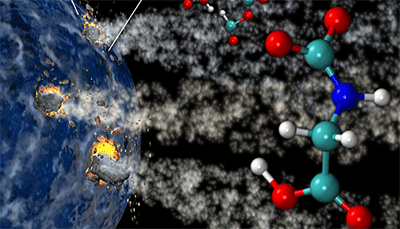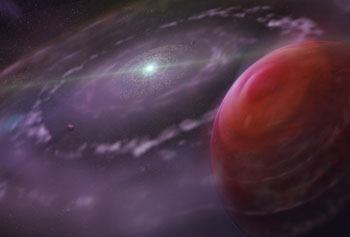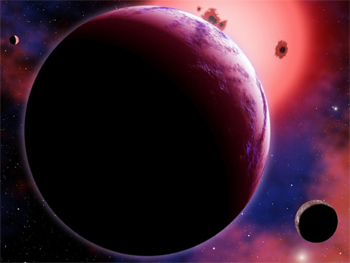The Press Room highlights computational astronomy work around the UC-HiPACC consortium; the wording of the short summaries on this page is based on wording in the individual releases or on the summaries on the press release page of the original source. Press releases below appear in reverse chronological order (most recent first); they can also be displayed by UC campus or DOE lab by clicking on the desired venue at the bottom of the left-hand column.
October 9, 2014 — Dead star shines on

High-energy X-rays streaming from a rare and mighty pulsar (magenta), the brightest found to date, can be seen in this new image of a galaxy called Messier 82 (M82), or the “Cigar galaxy,” combining multi-wavelength data from three telescopes. The bulk of M82 is seen in visible light captured by the National Optical Astronomy Observatory’s 2.1-meter telescope at Kitt Peak in Arizona. Starlight is white, and lanes of dust appear brown. Low-energy X-rays from NASA’s Chandra X-ray Observatory are shown in blue, and higher-energy X-rays from NuSTAR are pink.
September 4, 2014 — Edward Moses to lead Giant Magellan Telescope Organization

Ed Moses
July 17, 2014 — Peering into giant planets from in and out of this world

The interior of the target chamber at the National Ignition Facility at Lawrence Livermore National Laboratory (LLNL). The object entering from the left is the target positioner, on which a millimeter-scale target is mounted. Researchers recently used NIF to study the interior state of giant planets. Credit: Damien Jemison/LLNL
May 15, 2014 — Giant telescope tackles orbit and size of exoplanet

LLNL researchers and international collaborators have refined estimates of the orbit and size of the exoplanet Beta Pictoris b.
19 February 2014 — NuSTAR helps untangle how stars explode

The NuSTAR high-energy X-ray observatory captured this image of Cassiopeia A, a remnant that blew up as a supernova more than 11,000 years ago, leaving a dense stellar corpse and its ejected remains. Because the supernova was so far from Earth, the light only reached Earth about 350 years ago, when it may have appeared to be a new, bright star in the sky.
January 7, 2014 — Out of this world first light images emerge from Gemini Planet Imager. Second of 3 releases about GPI.

GPI team during the first light run in November 2013.
View full Lawrence Livermore National Laboratory press release
September 4, 2013 — It's a shock: Life on Earth may have come from out of this world

Comets contain elements such as water, ammonia, methanol and carbon dioxide that could have supplied the raw materials, in which upon impact on early Earth would have yielded an abundant supply of energy to produce amino acids and jump start life.
view full LLNL Press Release
June 5, 2013 — Life on Earth shockingly comes from out of this world

Synthesis of prebiotic hydrocarbons in impacts of simple icy mixtures on early Earth.
view full LLNL Press Release
March 14, 2013 — “Water signature in distant planet shows clues to its formation, Lawrence Livermore research finds”

Artist's rendering of the planetary system HR 8799 at an early stage in its evolution, showing the planet HR 8799c, a disk of gas and dust, and interior planets. Image courtesy of Dunlap Institute for Astronomy & Astrophysics; Mediafarm.
view full LLNL Press Release
December 12, 2012 — X-ray laser takes aim at cosmic mystery

A photograph of the instrument setup for an astrophysics experiment at the SLAC National Accelerator Laboratory''s Linac Coherent Light Source (LCLS), a powerful X-ray laser. The experiment was conducted in the Soft X-ray hutch using this electron beam ion trap, or EBIT, built at the Max Planck Institute in Heidelberg, Germany.
An international collaboration including researchers from Lawrence Livermore National Laboratory has refined a key process in understanding extreme plasmas such as those found in the sun, stars, at the rims of black holes and galaxy clusters.
In short, the team identified a new solution to an astrophysical phenomenon through a series of laser experiments.
In the new research, appearing in the Dec. 13 edition of the journal Nature, scientists looked at highly charged iron using the Linac Coherent Light Source (LCLS) free-electron laser at SLAC National Accelerator Laboratory.. Highly charged iron produces some of the brightest X-ray emission lines from hot astrophysical objects, including galaxy clusters, stellar cornae and the emission of the sun.
view full LLNL Press Release
October 22, 2012 — Milky Way's black hole getting ready for snack

Simulations of the dust and gas cloud G2 on its orbit around the Milky Way central black hole SgrA*. Photo courtesy of M. Schartmann and L. Calcada/ European Southern Observatory and Max-Planck-Institut fur Extraterrestrische Physik.
Get ready for a fascinating eating experience in the center of our galaxy.
The event involves a black hole that may devour much of an approaching cloud of dust and gas known as G2.
A supercomputer simulation prepared by two Lab physicists and a former postdoc suggests that some of G2 will survive, although its surviving mass will be torn apart, leaving it with a different shape and questionable fate.
The findings are the work of computational physicist Peter Anninos and astrophysicist Stephen Murray, both of AX division within the Weapons and Complex Integration Directorate (WCI), along with their former postdoc Chris Fragile, now an associate professor at the College of Charleston in South Carolina, and his student, Julia Wilson.
They came up with six simulations, using the Cosmos++ computer code developed by Anninos and Fragile, which required more than 50,000 computing hours on 3,000 processors on the Palmetto supercomputer at Clemson University in Columbia, S.C. ...
view full LLNL Press Release
October 4, 2012 — Livermore experiments illuminate how order arises in the cosmos

Plasmas stream from the top and bottom to form large-scale electromagnetic fields.
The surprising discovery of self-organized electromagnetic fields in counter-streaming ionized gases (also known as plasmas) will give scientists a new way to explore how order emerges from chaos in the cosmos. This breakthrough finding was published online in the journal, Nature Physics on Sept. 30.
"We've created a model for exploring how electromagnetic fields help organize ionized gas or plasma in astrophysical settings, such as in the plasma flows that emerge from young stars," said lead author Nathan Kugland, a postdoctoral researcher in the High Energy Density Science Group at Lawrence Livermore National Laboratory (LLNL). "These fields help shape the flows, and likely play a supporting role alongside gravity in the formation of solar systems, which can eventually lead to the creation of planets like the Earth."...
view full LLNL Press Release
June, 18, 2012 — Supercomputer at Lawrence Livermore National Lab passes 16 petaflops

From left to right in front of Sequoia: Bruce Goodwin, principal associate director for WCI, Dona Crawford, associate director for Computation, Michael Browne, IBM, Kim Cupps, leader of the Livermore Computing Division, and Michel McCoy, head of LLNL's Advanced Simulation and Computing program and deputy director for Computation.
Clocking in at 16.32 sustained petaflops (quadrillion floating point operations per second), Sequoia earned the No. 1 ranking on the industry standard Top500 list of the world's fastest supercomputers released Monday, June 18, at the International Supercomputing Conference (ISC12) in Hamburg, Germany. Sequoia was built for NNSA by IBM...
view LNLL Press Release
February 1, 2012 — LLNL: Scientists help define structure of exoplanets

The planet GJ 1214b, shown here in an artist's conception with two hypothetical moons, orbits a "red dwarf" star 40 light-years away from Earth.
LIVERMORE, Calif. -- Using models similar to those used in weapons research, scientists may soon know more about exoplanets, those objects beyond the realm of our solar system.
In a new study, Lawrence Livermore National Laboratory scientists and collaborators came up with new methods for deriving and testing the equation of state (EOS) of matter in exoplanets and figured out the mass-radius and mass-pressure relations for materials relevant to planetary interiors...more